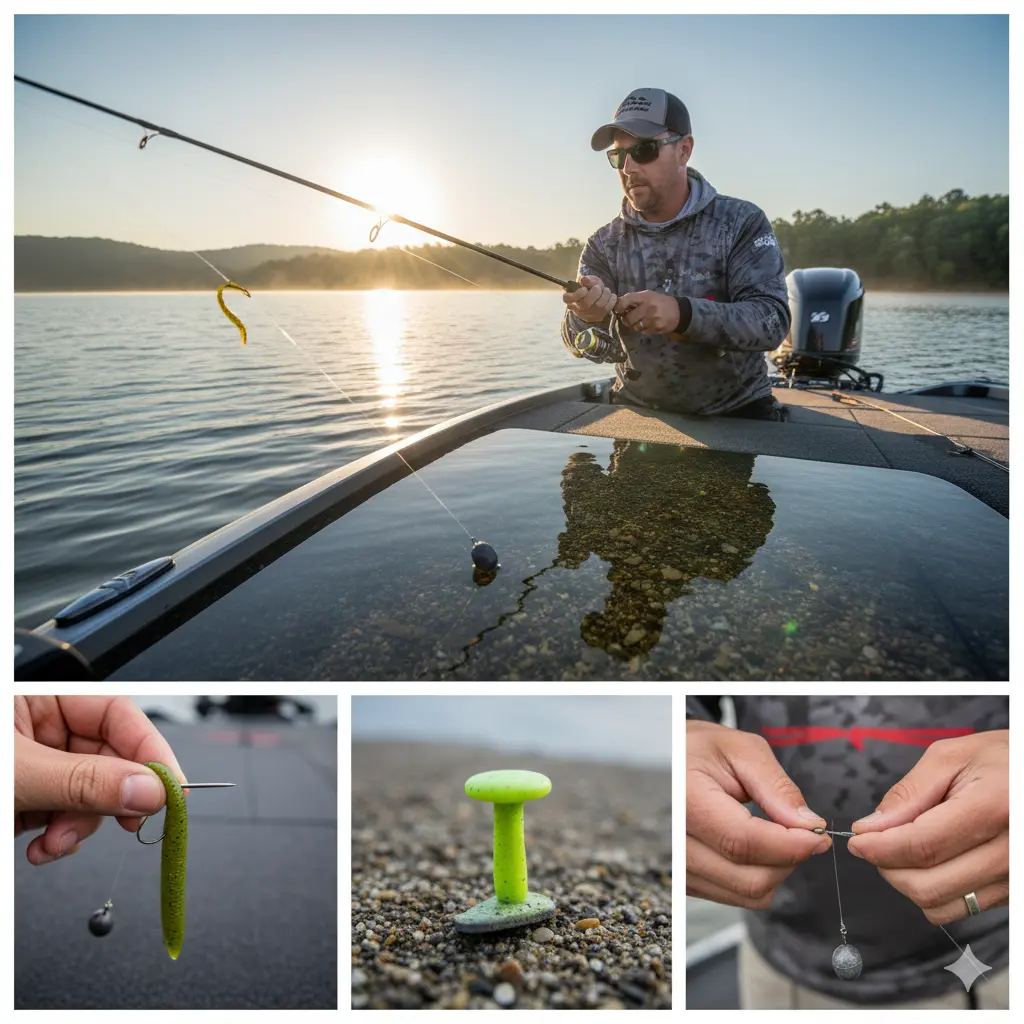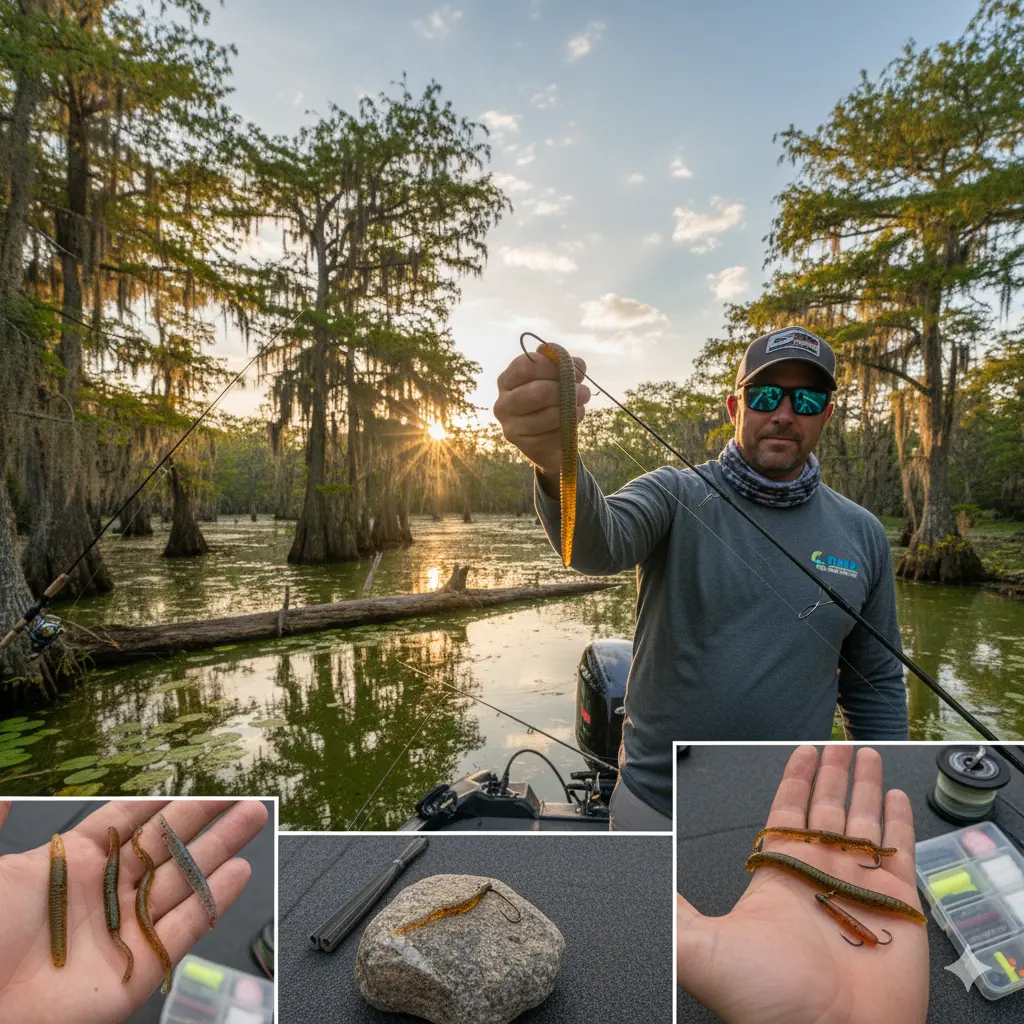Table of Contents
- Plastic Worms: The Bass Angler’s Secret Weapon
- Why Plastic Worms Dominate Bass Fishing
- Essential Plastic Worm Rigs for Bass
- The Texas Rig: A Timeless Bass Classic
- The Carolina Rig: Covering Water for Bass
- The Wacky Rig: A Finesse Favorite for Bass
- Advanced Plastic Worm Techniques for Bass
- Choosing the Right Plastic Worm for Bass
- Matching Plastic Worms to Bass Fishing Conditions
- Essential Gear for Bass Fishing with Plastic Worms
- Troubleshooting Common Plastic Worm Problems for Bass Anglers
- Frequently Asked Questions: How to Fish for Bass with a Plastic Worm
Plastic Worms: The Bass Angler’s Secret Weapon
If you’re asking “how to fish for bass with a plastic worm,” you’re on the right track to unlocking one of the most effective techniques in freshwater angling. Plastic worms are an absolute game-changer, celebrated for their uncanny ability to mimic natural forage and entice even the most cautious bass. This ultimate guide will walk you through exactly how to fish with plastic worms, covering essential rigs, dynamic retrieval methods, and expert tips to ensure you’re maximizing your bass fishing success in 2025.
Why Plastic Worms Dominate Bass Fishing
- Unparalleled Mimicry: Their soft texture and fluid movement perfectly imitate a wide variety of bass prey, from actual worms to baitfish and crawfish.
- Incredible Versatility: Plastic worms can be adapted to virtually any fishing environment – dense vegetation, rocky bottoms, open water, and deep ledges. This makes them a go-to for **bass fishing plastic worms**.
- Enticing Scent and Action: Many are infused with potent attractants, combined with their natural wiggle, they draw bass in and encourage them to strike aggressively.
- Finesse to Power: Whether you need a subtle, slow presentation or a robust bait to punch through cover, there’s a plastic worm rig for every scenario.
- Cost-Effective: Compared to many hard baits, plastic worms are budget-friendly, allowing anglers to experiment with a wide array of colors and styles.
Essential Plastic Worm Rigs for Bass: Your Go-To Setups
Mastering these foundational rigs is paramount for anyone learning how to fish with plastic worms for bass. These techniques will equip you to present your plastic worm effectively in diverse bass habitats.
1. The Texas Rig: A Timeless Bass Classic ⭐⭐⭐
When you’re asking “how to fish a plastic worm” in heavy cover, the Texas rig is your answer. It’s the king for punching through weeds and wood.
- Components: A bullet weight, an extra-wide gap (EWG) or offset worm hook, and your chosen plastic worm.
- How to Fish It: Thread your line through the bullet weight, tie on your hook, then run the hook point into the worm’s head, out the side, and then turn it to embed the point back into the worm’s body. This makes it weedless.
- Best For: Flipping and pitching into dense lily pads, thick grass mats, submerged brush piles, and fallen timber. Retrieve it with a lift-and-fall motion, feeling for subtle taps.
2. The Carolina Rig: Covering Water for Bass ⭐⭐⭐
For anglers looking for “how to fish plastic worms for bass” over expansive, open areas, the Carolina rig excels at finding fish on subtle bottom transitions.
- Components: A heavy sliding egg sinker, a glass or plastic bead, a barrel swivel, a fluorocarbon leader (2-4 feet), and your plastic worm.
- How to Fish It: After casting, drag the heavy sinker slowly along the bottom. The leader allows your worm to float or undulate just above the bottom, mimicking a baitfish or crawfish trying to escape.
- Best For: Fishing offshore humps, deep points, ledges, and rocky flats. It’s a great search bait for locating active bass.
3. The Wacky Rig: A Finesse Favorite for Bass ⭐⭐
When bass are finicky or in clear water, the Wacky Rig is a prime example of “fishing with a plastic worm” in a subtle, irresistible way.
- Components: A specialized Wacky Hook (or an octopus hook) and a stick bait-style worm (e.g., Senko). An O-ring can be used to prolong worm life.
- How to Fish It: Hook the worm directly through its center. The lack of weight (or minimal weight) allows for a slow, mesmerizing fall. Twitch your rod tip slightly to make the ends of the worm jiggle.
- Best For: Targeting pressured bass around docks, boat covers, submerged timber, and along weed lines in calm, clear water.
Advanced Plastic Worm Techniques for Bass
Beyond the basics, these techniques will deepen your understanding of “how to fish with plastic worms” in more specialized bass fishing scenarios.
The Ned Rig: Ultra-Finesse Bass Tactics
- Core Concept: A small, stand-up jig head paired with a short, buoyant plastic worm (often 2-3 inches).
- How to Fish It: Cast out and let it fall. Retrieve with minimal movement, short drags, and long pauses. The worm stands vertically on the bottom, mimicking a feeding creature or a dying baitfish.
- Best For: Highly pressured bass, cold front conditions, or when fish are lethargic and want a subtle presentation.
The Neko Rig: Weighted Finesse for Bass
- Core Concept: A stick bait-style worm with a nail weight inserted into one end, rigged wacky style with a Wacky Hook.
- How to Fish It: The weighted end causes the worm to fall headfirst, creating a unique quiver in the unweighted tail. Work it similarly to a wacky rig but with a more controlled descent and greater ability to probe vertical structures.
- Best For: Fishing docks, bridge pilings, and brush where bass are holding vertically.
The Drop Shot Rig: Precision Bass Placement
- Core Concept: Suspending a plastic worm at a precise depth above a weight, ideal for vertical presentations.
- How to Fish It: Tie a drop shot hook directly to your main line (leaving a long tag end), then tie a drop shot weight to the end of the tag. Cast out and let the weight sink. Keep your line tight and gently shake your rod tip to impart action without moving the weight.
- Best For: Targeting suspended bass, fishing vertically over structure, or presenting a worm directly in front of bass located with your fish finder.
Choosing the Right Plastic Worm for Bass
The vast selection of plastic worms can be daunting. Here’s how to select the optimal worm for your specific bass fishing scenarios:
- Curly Tail Worms: The classic “action” worm. Its prominent curly tail generates significant vibration and movement, making it great for Texas and Carolina rigs when bass are aggressive.
- Stick Baits (e.g., Senko, Yamamoto D-Shad): Known for their subtle action and incredibly natural “shimmy” on the fall. Quintessential for Wacky and Neko rigs, especially in clear water.
- Ribbon Tail Worms: Create a lot of commotion and visual appeal with their elongated, fluttering tails. Excellent for covering water quickly or in stained conditions where bass rely more on vibration.
- Straight Tail Worms: Offer a subtle, straight fall, making them ideal for finesse presentations like the Ned Rig or drop shot, particularly when bass are picky.
Matching Plastic Worms to Bass Fishing Conditions
- Clear Water Bass: Opt for natural, translucent colors (green pumpkin, watermelon, natural shad). Employ finesse presentations like Wacky, Ned, or Drop Shot rigs for minimal disturbance.
- Murky or Stained Water Bass: Choose darker, high-contrast colors (black, blue, junebug) to create a more prominent silhouette. Rigs with more inherent action, such as a Texas rig with a heavier weight or a ribbon tail worm, will help bass locate the bait.
- Heavy Cover Bass: The Texas rig is paramount for navigating through thick vegetation, submerged timber, and brush piles without snagging. Use heavier fishing line (15-20 lb fluorocarbon) to ensure you can extract bass from the cover.
- Open Water Bass: A Carolina rig or a drop shot rig is perfectly suited for efficiently fishing offshore structure, including humps, ledges, and deep points where bass often school.
Essential Gear for Bass Fishing with Plastic Worms
Having the correct tackle is not just important—it’s critical for effectively presenting plastic worms and successfully landing your bass.
- Rod Selection: A medium-heavy, fast-action spinning or casting rod (typically 6’8″ to 7’4″ in length) offers the ideal balance of sensitivity for detecting subtle bites and backbone for powerful hooksets.
- Reel Choice: For baitcasting setups, a high-speed baitcasting reel (with a gear ratio of 7.1:1 or higher) is highly beneficial for quickly taking up slack line and managing presentations. For spinning, a 2500-3000 series reel provides versatility.
- Fishing Line: Fluorocarbon is the unequivocal top choice for **bass fishing with plastic worms** due to its superior low visibility underwater, minimal stretch for enhanced sensitivity, and excellent abrasion resistance. Use 10-15 lb test for most bass fishing applications.
Troubleshooting Common Plastic Worm Problems for Bass Anglers
Even experienced anglers encounter challenges when fishing a plastic worm. Here’s how to quickly address common issues:
- My worm keeps getting torn or sliding down the hook: For Wacky rigs, use an O-ring around the worm to prevent tearing. For Texas rigs, ensure your hook point is just skin-hooked into the plastic body, not fully exposed, and try using a worm stopper or pegging your weight.
- I’m not getting any bites: This often indicates a need for adjustment. Try experimenting with a different worm color, size, or an entirely different rig. Crucially, slow down your retrieve significantly. Bass can be less active than you think.
- I’m missing too many hooksets: Patience is key. Avoid setting the hook at the first tap. Instead, wait until you feel the fish move off with the bait or apply steady pressure. When they start to swim away, drop your rod tip, reel down to take up slack, and then execute a sharp, powerful hookset.
Frequently Asked Questions: How to Fish for Bass with a Plastic Worm
Q: How do you fish with plastic worms effectively? A: Effective plastic worm fishing involves choosing the right rig for the conditions (e.g., Texas rig for cover, Carolina rig for open water), matching worm color to water clarity, and employing a slow, deliberate retrieve with pauses to entice strikes. Pay close attention to subtle bites! Q: What is the best way to fish for bass with a plastic worm? A: The “best” way often depends on the scenario, but starting with a Texas-rigged straight tail or ribbon tail worm, cast into cover and slowly retrieved with a lift-and-fall action, is a highly consistent method for catching bass. Q: How to fish a plastic worm for bass in thick vegetation? A: For thick vegetation, the **Texas rig** is paramount. Use a bullet weight heavy enough to penetrate the cover (e.g., 1/4 oz to 1 oz) and a robust EWG hook. Flip or pitch your worm into pockets and along edges, letting it fall vertically. When it hits the bottom, lift it slightly and let it fall again. Q: What’s the best retrieve for fishing plastic worms for bass? A: For most plastic worm rigs (Texas, Carolina, Ned), a slow, methodical retrieve is best. This typically involves lifting your rod tip gently, reeling in slack, and letting the worm fall back to the bottom. Varying pauses and subtle twitches can trigger strikes. Q: What’s the secret to “bass fishing plastic worms” successfully? A: The secret lies in patience and sensitivity. Plastic worms excel when fished slowly, allowing bass time to inspect and commit. Develop a keen sense for subtle bites, as bass often pick up worms very gently.



